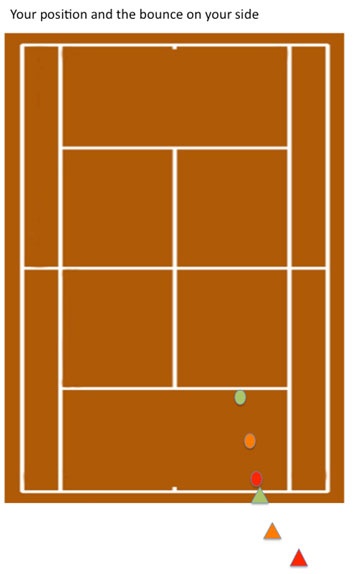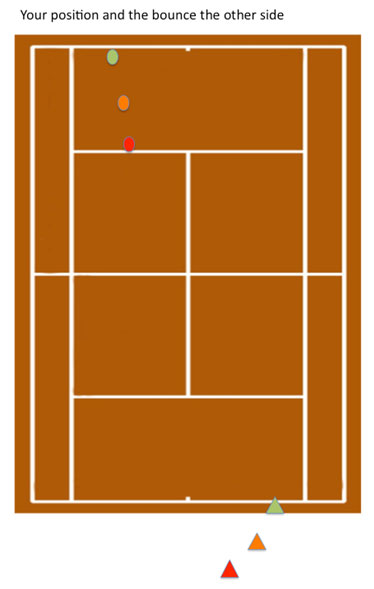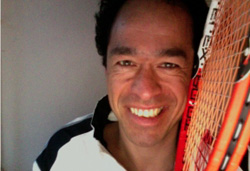|
TennisOne Lessons That's the way the ball bounces (twice…) Jerôme Inen Sometimes a teaching pro gets the honor to do a lesson or seminar with other teaching-pro’s. One of my favorite part of these outings is: "Show us your favorite drill." Because I am a bit of tease, I will usually pick a drill that will confuse my fellow-coaches because it goes against the grain of their particular beliefs about the game. So, if I am in the company of coaches who train a lot of high-ranked juniors, I know one of their most favorite rules is: ‘Don’t play too far behind the baseline, and, whenever possible, take the ball on the rise.’ Of course yours truly will give them this assignment: play a baseline-rally in which you have to let the bounce ball… twice. You would not believe how chaotic the first few minutes of this exercise develops. Extremely skilled players who hit millions of tennis balls each year, scramble all over the court to get into the right position. They are amazed and befuddled how far and how high a tennis ball actually bounces.
Then, when they actually have succeeded in playing rally’s, I ask them: "Now play a rally in which the ball bounces once… but you are not allowed to change position AFTER the ball has bounced." Again mayhem. Sometimes these very skilled players actually fall over when they try to hit the ball. I stop the exercise, and say: "The trick is to move as if you are going to let the ball bounce twice… and just before the ball bounces you take one step forward." From that moment on, the chaos is over. The players start to move as if they are one with the ball. They do most of their moving before the ball is even over the net! They discover they have loads of time to get into position, and not move their feet more than for a slight shuffle and hit the ball. This story illustrates one of my strongest gripes with typical tennis-instruction: it focuses a lot on ‘how do we hit a ball the best way’ (like Federer) and seldom on why do we hit the ball the way we do? (Or why does Federer?). A major cause of this fault is the underestimation of how the bounce of the ball determines what happens on the tennis court. In an earlier article Tennis without a pro?...No, I talked about the fact on the internet you can find 4 million pages of instruction on how the hit the forehand… and 3,5 million of them don’t even mention the word "bounce of the ball." I will not elaborate on that side of the story (read the article!). But I want to dig deeper into the second bounce of the ball as a yardstick for playing a good game. The usual response after doing the exercise described above is: ‘But I move this way, I am moving really far behind the baseline… and then I have to move forward again to hit a shorter ball! That is not how the pro’s play! They play on top of the ball on the baseline all the time!’
Well, that is a fallacy. I know a lot of coaches emphasize that you have to move your opponent behind the baseline, so you can play on top of it, but… that is the ideal world. You can only play on top the baseline if your opponent lets you do that! That means when the bounce of his shot on your side of the court allows you do that! Take Andre Agassi. He was the supreme, aggressive baseliner who took the ball really earlier and punished his opponents by standing on top of the baseline. But… even Andre had to work his way into position before he could do that! Here’s Andre Agassi (video above) ready to swipe his forehand fast and furious. But see where the ball will bounce. Try to calculate where the ball would have bounced for the second time. I will tell you: about a yard behind the baseline... the position Agassi was in when the ball had not yet crossed the net! This, for Agassi or any other top-player is the ideal situation. He has more than enough space between himself and the ball. He can take a full shoulder turn. He can move his weight forward into the ball. He can create an angle. He can hit inside out. He has a ton of options. Ideally, a top-player or any tennis player would like to be in the position where the ball would have bounced for the second time! That means, in fact: waiting for the ball about nine feet away from the bounce.
So, are players like Agassi or Federer positioned there all the time? Of course not. Watch as Roger Federer hits one of his jaw-dropping forehands after a shot that lands deeper than he would have wanted. Fantastic solution of the master… but do we want to emulate that or teach it to our students? No, this is a match situation in which arguably the best player of all times uses his athleticism, superior skills and lightening reflexes. Notice how his front foot is off the ground. He hits a great shot… but he would have preferred to be able to transfer his weight forward into the shot. A former coach once said to me: ‘A typical B-player will run along the baseline to intercept a ball. A typical A-player will run back and then forward to intercept a ball.’ The next picture of Federer illustrates his thoughts. A Federer in control, now, not under siege.
In the video, after Federer has made his split-step. I’ve put a red line through his body. After Federer has moved forward to hit his shot and makes contact. The red line is at the original position. You see that Federer has transferred all his weight forward. You also see that he moved forward considerably to hit his forehand. Tennis, alas my dear friends, is a game of moving not only from side to side, not only from back to front, but also from front to back again. How much you have to run depends on your skills, your style of play, and your fitness… but if you think you can find one ‘ideal’ position on the court and play for the rest of your life on that spot, you have another thing coming. So, how can you use the second bounce to help your game? Do the Second Bounce Exercise I described how to do this drill in the first few paragraphs. What is important is that at first you get the feel of ‘spacing’ between you and the first bounce. After that, you will notice you slowly start to measure that space before the ball has even bounced on your side of the court. If do you this exercise right you even move to the right position to hit before the ball has even bounced! Even if I do this exercise myself, I am amazed how lazy my footwork actually is during ‘normal’ tennis. I discover again and again how I tend to put myself into the wrong position. From there I have to salvage the situation instead of determining play myself. So I use the second bounce exercise to remind myself: that this is how I should move, lazy bones! When Practicing Alone, Do Drop-Hits and Watch the Second Bounce When you’re alone on a practice-court and have a bucket of balls, do some drop-hits. But from now on don’t try to focus on how you are hitting the ball like Federer (form), but focus on what you try to achieve with the second bounce (function). The second bounce is an excellent way of measuring the worth of your shot. When you try to hit angled shots from drop-hit: and you hit a shot that is close to the sideline; my compliments. But where does it bounce the second time? How high does it bounce after the second bounce? Because that is where your opponent will probably be when he attempts to hit the shot back. With the first serve, you obviously, you want the ball to land in the service-box and then bounce straight into the back-fence. But can you do that with the second serve too? That is a bit harder. How far does it bounce? How high after the first bounce? How high does it bounce after the second bounce? Learn Basic, Second Bounce Positions for your Own Position
In the diagram, the colored circles represent the ball on your side of the court. The triangular shapes show where your general position should be. That means, if the ball bounces at about the baseline line, you are fine standing at or just behind the service line. But with every distance the ball bounces further than that, you should move back farther. So if the ball bounces halfway between the service line and the baseline, you should be about six or seven feet behind the baseline. If you look at the red dot, I may not have placed the corresponding red triangular not far enough back. If your opponent hits that deep, you should probably be with your back against the fence! Again, this is a very general suggestion. Start with this, and slowly you can determine for yourself what your depth should be.
Learn the Basic, Second Bounce Positions For Your Opponent
Wouldn’t it be great if you could predict your position on the court before your opponent has hit the shot? Well, you can, and you don’t need to be psychic to be able to do that. Just watch (and later predict!) where your shot is going to land. Because that will tell you pretty much where you will able to stand to receive your opponent’s shot. If you hit the red circle, you’ve hit quite a shallow shot. Your opponent will we able to hit it straight forward, sharp crosscourt or whatever. Chances are, he will hit hard and deep. You have to prepare for a deep bounce on your side of the court. Haul back, I say! If your ball bounces at the orange spot, you are kind of in a neutral state. You are neither dominating the point, nor on the defense. Find a neutral position, about five to six feet behind the baseline. If your ball lands in the green spot, for god’s sake, move in. If your opponent is smart, he will hit a high deep shot. In the worst case, you will have to move back again. Most probably, though, your opponent will try to hit a desperate shot… that will either fly or land flat, hard… and short. Be ready for it. Know Thyself Before and during matches, find your basic depth against your opponent. One of the best things I’ve done with my own game in the past four years is to play against different opponents during the same practice-session. Why? Because I get forced that way to respond to shots that are hit to me, instead of finding a particular spot on the court and try to do everything from there. Some players hit hard and flat. Some hit with slice, some with spin. Some have spin that bounces straight up, other shoot through. Some can even make the ball spin side-ways (oh, those darned lefties!). The rule is: find your basic position against a particular player you are playing against. As a rule of thumb: if you are stronger than your opponent (or if he is a defensive player), move close to the baseline. If he is as strong as you or perhaps even stronger: start about your own length behind the baseline.
During the warm-up, just let a ball pass sometimes. Watch where the ball bounces the second time… and how it bounces. Some players hit very deep… but the ball bounces the second time well before the back fence. Some players hit consequently halfway between service line and baseline… but their second bounce is almost in the back-fence because of the pace and/or spin. Those players are to be feared! But more important in this part of the second bounce lesson is to know thyself. Your basic, second bounce position depends on your game. Are you fit? Are you able to position yourself the whole time at the second bounce? It will give you the chance to move forward into the ball all the time, but it will cost you terms of leg time. Are you someone who likes set yourself up for the shot, like Federer and Lendl? Or are you more of the quicksilver movers, who only stop moving your feet just before you strike the ball? Do you have quick reflexes or are they okay'ish? Do you have long or short strokes? Are you able to take the ball an the height of the bounce? Are you able to do it as well on both wings? Just do the second bounce exercise now and then, try to remember during normal play how you move and anticipate during that exercise… and use it. You will get a new bounce to your game, I promise!
Your comments are welcome. Let us know what you think about Jerôme Inen's article by emailing us here at TennisOne.
"I’ve learned tennis the traditional, form-oriented way — and it is not the right way! Lijftennis is my attempt to show other people a way to learn quicker, with better results and less frustration. If I have one message: don’t copy others, play and learn from your own body and perspective!" |
 Later I will talk about individual positions on the tennis court. But before you find those, you have to know the basic, second bounce positions in general.
Later I will talk about individual positions on the tennis court. But before you find those, you have to know the basic, second bounce positions in general.
 Jerôme Inen of
Jerôme Inen of